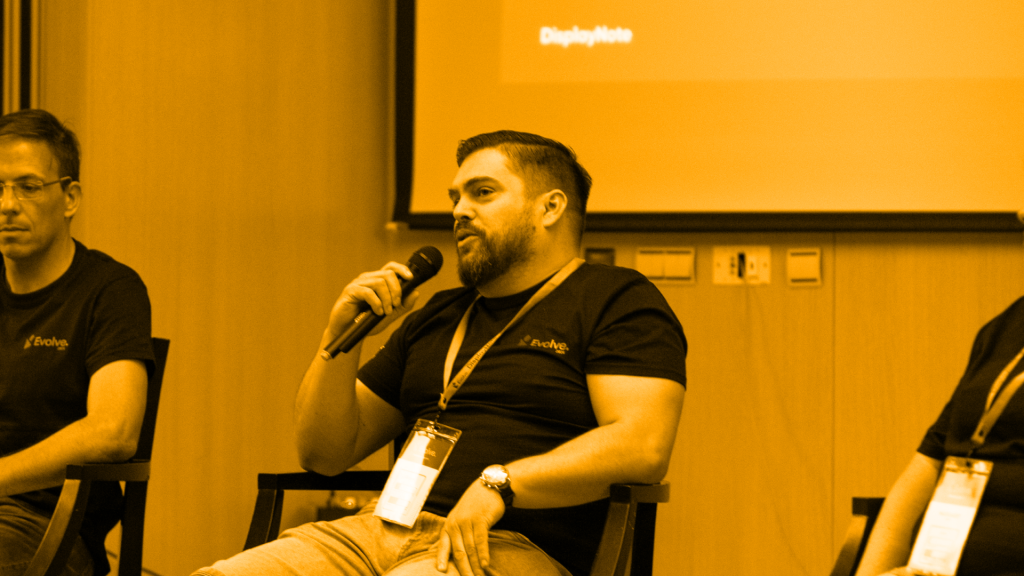
Access Denied: How to Create a More Digitally Inclusive Workplace
 Julie Adams
•
Oct 13, 2020
Julie Adams
•
Oct 13, 2020
In the modern workplace, technology has become a by-word for productivity, innovation and success. As ‘born digital’ companies like Amazon and Google became mammoth entities in a relatively short space of time, traditional industry players started to feel the heat. In an attempt to reposition themselves as digital leaders, the industry experienced a widespread rush to adopt new technologies for fear of becoming irrelevant.
“Any sufficiently advanced technology is indistinguishable from magic.” Arthur C. Clarke

Large chunks of budgets historically allocated to traditional functions are now being spent on digital transformation initiatives: Lego developed an engagement platform to facilitate internal communication. Porsche created a CRM system that generated a unique ID code for each customer to record details of the buying cycle. Industry experts as Goldman Sachs suggest the development of the public cloud has also seen disruption to old, establishment behavior, with cloud-computing and software promoting more agile working habits.
An astonishing 97% of decision-makers report a speed-up in the rate of digital transformation within their business in response to the COVID pandemic. But what role do new technologies have in today’s hybrid meeting rooms, and more importantly, do they work?
Meeting room technology represents a significant investment in many workplaces. This can be explained in part by the globalization of markets, and by the quest for more integrated workplaces. Gone are the days of pen and paper meetings. Today’s huddle spaces are interactive and collaborative. The monopolistic market, once dominated by Windows, has shifted to a more oligopolistic model. Ask any professional what software they rely on today, and they’re likely to give you a long and varied list. Duo, Google Drive, Salesforce, Zoom, Slack, Sharepoint, Skype, I’ll stop there. The point is, teams are collaborating across a multitude of platforms more than ever.
And this can be only a good thing, right? Well, that depends.
The Collaboration Paradox

With an abundance of choice also comes an abundance of elements to align. This can be a headache for employees and employers alike. The sharing of ideas is powerful, but seamless collaboration only happens when the right channels are in place.
What happens when your colleague uses a different word processor to you, or the shared computer in the meeting room doesn’t have the video software you like to use installed. What happens when the main meeting room is occupied, and the person about to present isn’t sure how to set-up the other room?
Research conducted by Steven Rogelberg at the University of North Carolina found a correlation between meeting effectiveness and employees’ feelings of satisfaction or dissatisfaction with their job overall, even when controlling for variables like personality, task type, and supervision.
This evidence suggests that what happens in the meeting room significantly impacts what happens outside the meeting room too.
We’ve created a run-down of how to make technology more inclusive in your meeting space.
1. Digital Inclusion is a Social Issue.
Over the past decade, an emphasis has been placed on creating more accessible education and workplaces for individuals with disabilities or distinctive needs. Still, some could argue that technology and digital literacy are part of the new barriers to entry when it comes to equality in the modern workplace. What’s more, research conducted by LSE found a relationship between digital exclusion and adverse life outcomes for individuals.
What are the impacts of digital exclusion?
- Less access to jobs and education
- Poor health and lowe life-expectancy
- Increased loneliness and social isolation
- Paying more for essentials
It may not come as a surprise to discover that some people experience a specific form of anxiety when it comes to working with new technology, official name ‘technophobia’. Research has indicated that around a quarter (26%) of workers surveyed feel challenged or unable to cope with advanced technology, with only about a third (34%) saying they feel comfortable.

Even for those not in technical roles, chances are they’ll use meeting rooms for presenting or holding calls. If unfamiliar with the technology in the room, they’re more likely to run into issues with setting-up and launching apps, which can be both embarrassing and time-consuming for them and the attendees.
Simon Parkinson, chief executive of the WEA (a UK charity providing adult education), explains that 11.5 million adults in the UK lack basic digital skills, which translates to a £64 billion loss in GDP in skill gap each year.
As almost 50% of us went into remote working towards the end of March, working with digital tools has become somewhat unavoidable. For example, business decision-makers surveyed by The Times reported a 48% increase in the use of video conferencing tools within teams, with 29% using the tool for the first time. Given the scale of the issue of digital inclusion, this points towards a work climate that is becoming increasingly hostile for those less comfortable with technology.
The question then, is, how do you address these knowledge gaps, and what steps can you take to make meeting room technology more accessible?
2. Perspective is Key

As a system integrator or business leader, it can be easy to take your own knowledge for granted. Staying tuned in to the latest tech developments is often crucial when it comes to running a business, particularly if your company operates within e-commerce. However, the problem then arises when work systems are designed without sufficient consideration of the knowledge-levels of other members of the team, members who may be less au fait with the latest technologies.
Digital inclusion doesn’t stop at addressing confidence and knowledge gaps. Physical and cognitive impairments are also vital to take into consideration when designing meeting room spaces. When it comes to things like vision or hearing loss, individuals often feel embarrassment around bringing the subject up.
Our Launcher meeting room interface is designed for the large format display. This means that our text is usually larger and the points of interaction are rather large. The mobile-app integration also allows for contact-free call launching from the comfort of your personal device.
Research conducted by Odai Khasawneh of the University of Wisconsin (2018), found that transformational leadership plays a role in helping employees overcome technophobia in the workplace.
Furthermore, his study uncovered that to achieve this digital inclusion, an assessment of the style of leadership and the technophobia present is imperative. Which leads to the next point…
3. Conduct an Audit
To implement change, a business must first take a step back and ask: are the systems in place sufficiently accessible and user-friendly for all members of staff? What are the gaps in knowledge, and how can we address them?
An anonymous employee survey can be a good starting place to establish your team’s level of knowledge and assess whether current tools are useful.
Are teams presenting work across different platforms? Is there a preferred video conferencing tool in meeting rooms? Are huddle spaces standardized for a similar collaborative experience across the business?
Answering these questions will help you to identify sticking points in your current IT systems plus areas where employees might benefit from further training and development. Consulting with your IT team will provide valuable insights to which areas create the most issues support wise, ultimately reducing the number of queries and call-outs in a day.
4. Fill Knowledge Gaps

The knowledge gained from reviewing your processes and team attitudes will inform what type of training to implement if needed. In-person training can be more effective than online tutorials in that learners can troubleshoot specific pain-points and have someone explain complex systems in the context of their role. Plus, the physical proximity to the trainer can improve confidence and learning outcomes.
Creating digital accessibility starts with creating an atmosphere of support and acceptance, where employees can build their skills without fear of criticism.
5. Don’t Let Inertia Take Over
When you have invested in a full digital outfit as a business, it can be painful to consider the prospect of upgrades or changes to your systems. 35% identify the reluctance to replace legacy software as a barrier to digital transformation. But if employees are struggling to get the most out of the current set-up, is keeping things as they are really the solution?

In a way, the coming months present an exciting carte blanche for organizations to carve out an entirely fresh model of working, which explains why 79% of decision-makers have increased their budget for digital transformation post-COVID.
Technology manufacturers are inevitably going to play a vital role in adapting their product offerings to reflect the hybrid model of ‘safe working’ that has emerged.
Companies may indeed opt for a transition to more user-friendly, software-based computing, with a shift away from rigid, traditional hardware that plagues IT departments.
Technology for the Accessible Workplace
At DisplayNote, we recognize the problems integrators and business owners face when it comes to implementing new technology. We created Launcher, a meeting room solution that simplifies the set-up and management of meeting rooms across your business. Launcher acts as an interface for the meeting room display, giving users a home-screen where they can launch calls, present, and share ideas at the touch of a button.
- Launcher works with the apps your teams are familiar with, to keep the meeting room accessible, inclusive, and collaborative.
- Remote sign-in with the Launcher mobile app enables access to 365 accounts from your personal device, so users can start calls on the meeting room display without touching a screen or shared computer.
- With Kiosk mode, system installers have complete control over what apps and features attendees can access. This allows standardization of meeting spaces across the business, reducing set-up time, and IT queries.
Discover the benefits of Launcher in your business with a personalized demo
About the Author
This article is written by Julie Adams, a Communication & Content Specialist at DisplayNote. Julie is a writer and science, psychology & music enthusiast.
Want to stay in the loop?
Keep up-to-date with everything DisplayNote – including new releases, job openings, and customer giveaways.
Don’t worry, we’ll not spam you and we’ll never share your email with anyone






